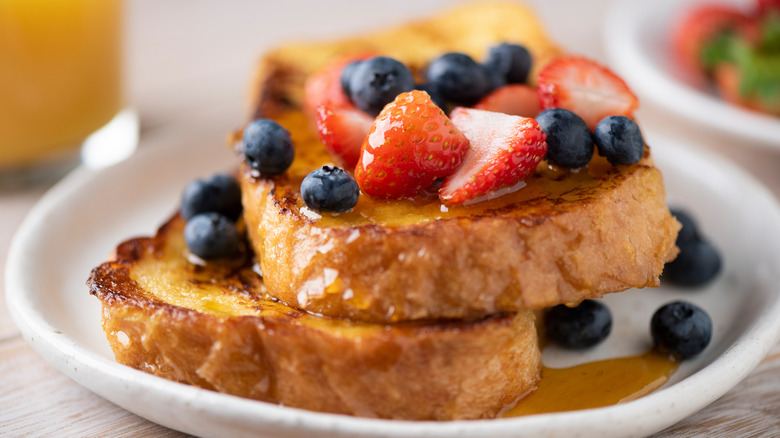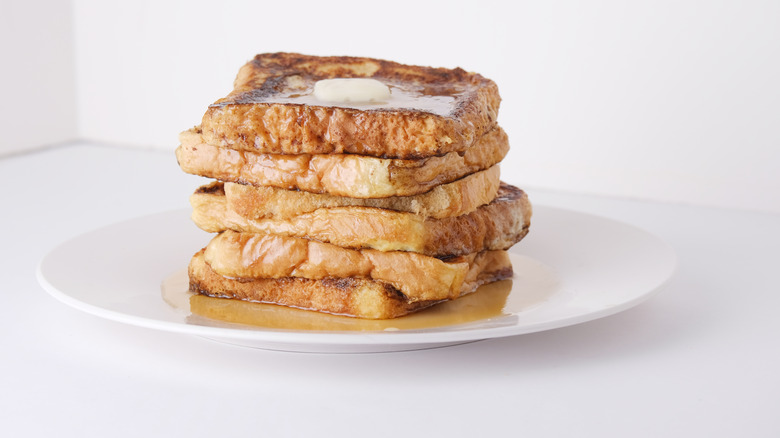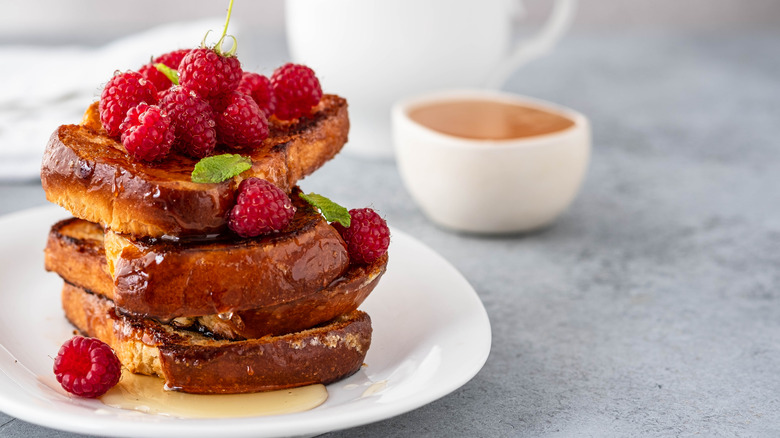There Is An Exact Right Thickness For Perfect French Toast
Nothing says good morning like a plate of French toast. For something that is incredibly simple on paper, consisting of an ordinary slice of bread that's been dredged in egg or custard and then fried in a pan, French toast is an incredibly popular breakfast food. Whether you serve it with maple syrup and powdered sugar or made into a Bananas Foster or blueberry sauce, the foundations of French toast remain unchanging.
But just because it's a simple recipe doesn't mean that even the slightest change in procedure could result in a poor end result. If your bread is too thin, the custard in the middle soaks through and the bread tears apart like a piece of wet paper. If the bread is too thick, the custard won't soak through all the way and you'll wind up eating a moist piece of spongey flavorless bread. There has to be an exact level of thickness to the bread, where it's just thick enough for the bread to hold but thin enough for the custard to be fully absorbed. That's why there are those who claim that, for the perfect piece of French toast, you need a slice of bread that's at least 1” thick.
What exactly makes this certain width so good for French toast? How can we be sure it's not thin or too thick? If it does work, are there any particular types of bread that you should keep in mind when making the so-called "perfect" French toast?
Is 1'' the perfect width for your French toast?
Some may think that a slice of bread 1” inch thick is too thin for French toast, while others may argue that it's too thick. The only way we can settle this is to have testimony over whether or not this is indeed the correct thickness.
Taylor Ann Spencer of Delish argues that the keys to a good French toast lie in the thickness of the bread and the time said bread spends in the pan. Spencer claims that a 1” cut of bread is thick enough to not only absorb the custard but thin enough that it can cook quickly in the pan. This is also important, as too much time spent in the pan can cause the bread to dry out or burn. A 1” thick piece of bread cooked for 3 minutes on each side at medium heat, claims Spencer, is just enough to fully cook the bread and create an even creamy center and golden texture.
Although 1” is a good thickness to shoot for when making regular French toast, you may want a somewhat thinner cut of bread if you're preparing stuffed French toast. For stuffed French toast, you'll want a slice of bread that's half an inch thick instead of 1” on account of all the toppings and fillings you'll be adding. In short, 1” is a very good thickness for your French toast, though don't be too worried if you're not exactly on the level.
What sort of breads are the best for French toast?
When you make French toast, you probably rely on white sandwich bread to make it. While there's nothing wrong with using it, the fact that it comes pre-sliced means that you're not able to get that perfect 1” cut you'll need for a good French toast. What you need is bread that can be sliced thick and will be strong enough to hold all of that custard without falling apart in the pan.
A few good choices when selecting your bread include brioche or challah bread. Brioche is a sweet, fluffy bread that originates from France, boasting a very high content of butter, eggs, and milk when compared to your regular pre-sliced sandwich bread. It is this high milk, butter, and egg content that gives brioche a very light, rich texture — perfect for use when preparing French toast, as this will compliment the custard the bread is soaked in. Challah bread is a good choice because it also has a buttery and soft texture alongside being slightly sweet. If both loaves of bread are cut to 1”, they can make a perfect French toast — thick, soft, and sturdy without being an overly spongy mess.
If you're unable to find brioche or challah bread, you can also use French bread to serve as a substitute. Not only is French bread thicker than sandwich bread but their firmer crusts give a nice contrast to all the soft butteriness of the custardy interior.


